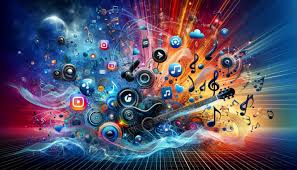UP Transport Department WhatsApp Chatbot : Get Driving License & Vehicle Details Instantly
Music in the Digital Age: The Bright Future of Music in the Digital Age (2025)

Music
The digital revolution has transformed nearly every aspect of modern life, and the music industry is no exception. Advances in technology have significantly changed how music is created, distributed, and consumed. From digital audio workstations (DAWs) enabling independent production to streaming services redefining accessibility, technology has reshaped the landscape. This article explores the profound impact of digital advancements on both music production and consumption, examining the benefits and challenges that have emerged in the process.

The Evolution of Music Production
The Shift from Analog to Digital Recording
Historically, music production relied on analog equipment, including tape recorders, mixing consoles, and vinyl pressings. However, the advent of digital recording in the late 20th century revolutionized the industry. Digital audio workstations (DAWs) such as Pro Tools, Logic Pro, and Ableton Live have enabled artists and producers to create, edit, and mix music with unprecedented flexibility and precision.
Digital recording has also improved audio quality by reducing noise interference and allowing for greater dynamic range. Additionally, the affordability of software-based production tools has democratized music creation, empowering independent musicians who no longer need access to expensive studio equipment.

Virtual Instruments and Sampling
Technology has also revolutionized instrumentation through virtual instruments and sampling. Synthesizers, drum machines, and orchestral plugins enable artists to produce high-quality music without requiring physical instruments. Moreover, advancements in artificial intelligence (AI) and machine learning have led to the development of AI-generated compositions and algorithmic music production, pushing creative boundaries even further.
The Rise of Home Studios
In the past, music production required expensive studio time, but today, many artists produce professional-grade music from home. High-quality microphones, audio interfaces, and DAWs allow musicians to record and mix their work without the need for traditional studio spaces. This shift has given rise to a more independent music industry where self-produced artists can achieve mainstream success.

The Transformation of Music Distribution
The Decline of Physical Media
Before the digital age, music distribution relied on physical formats such as vinyl records, cassette tapes, and CDs. With the rise of digital downloads and streaming services, physical media sales have declined significantly. Although vinyl has seen a niche resurgence, the majority of consumers now access music digitally.
The Streaming Revolution
Streaming services such as Spotify, Apple Music, and YouTube Music have fundamentally changed how audiences consume music. Listeners now have access to vast libraries of music at their fingertips, often at little or no cost. Subscription-based models and ad-supported platforms have replaced traditional purchasing methods, leading to a decline in album sales but an increase in overall music accessibility.

However, streaming services have also sparked debates about artist compensation. While these platforms provide exposure to millions of listeners, many artists receive only a fraction of a cent per stream, making it challenging for independent musicians to earn a sustainable income.
The Role of Social Media in Music Promotion
Social media platforms like TikTok, Instagram, and Twitter have become essential tools for music promotion. Viral trends and challenges on TikTok, for instance, have propelled songs to mainstream popularity, sometimes even reviving older tracks. Independent artists can now reach global audiences without relying on record labels, leveraging social media algorithms and influencer collaborations to gain traction.

The Changing Landscape of Music Consumption
Personalized Listening Experiences
Artificial intelligence and big data have enabled personalized music recommendations. Streaming services use sophisticated algorithms to analyze user preferences and suggest tailored playlists, enhancing the listening experience. AI-driven curation has made music discovery more accessible, helping listeners find new artists and genres with ease.
The Impact of Digital Piracy
While streaming services have curbed illegal downloads to some extent, digital piracy remains an issue. File-sharing platforms and unauthorized streaming sites still contribute to revenue losses for artists and record labels. However, advancements in digital rights management (DRM) and blockchain technology offer potential solutions to protect intellectual property rights and ensure fair compensation for creators.

Live Streaming and Virtual Concerts
The COVID-19 pandemic accelerated the adoption of live-streamed performances and virtual concerts. Artists have embraced platforms like Twitch, YouTube Live, and Facebook Live to engage with audiences in real-time. Virtual reality (VR) concerts are also emerging, providing immersive experiences that replicate the atmosphere of live shows.
Challenges and Ethical Considerations
Despite its benefits, technology-driven music consumption presents several challenges. The dominance of streaming services has led to concerns about fair pay for artists, with many advocating for more transparent revenue-sharing models. Additionally, the over-reliance on algorithms in music discovery raises concerns about artistic diversity, as mainstream trends often overshadow niche or experimental genres.

Conclusion
Technology has undeniably revolutionized the music industry, reshaping both production and consumption in profound ways. Digital tools have democratized music creation, while streaming platforms have expanded accessibility like never before. However, these advancements also present challenges, particularly regarding fair compensation and artistic visibility. As technology continues to evolve, the industry must adapt to ensure that both artists and audiences benefit from the digital transformation of music. Ultimately, striking a balance between innovation and sustainability will be key to the future of music in the digital age.
ALSO READ THIS: The Future of Film and Television 2025: Trends in Streaming and Content Creation with a Thriving Era of Innovation and Storytelling”


